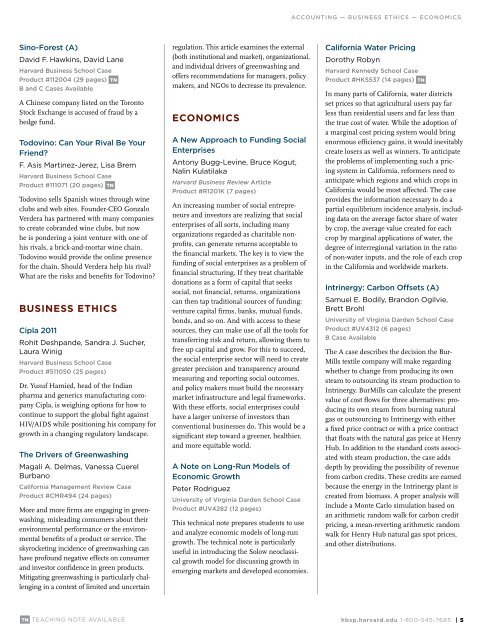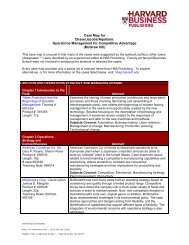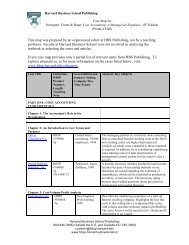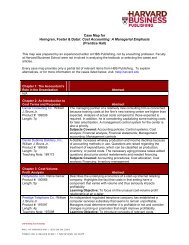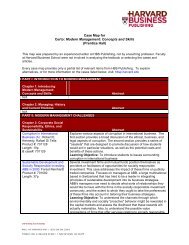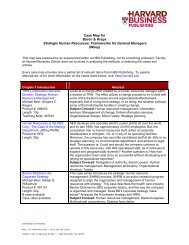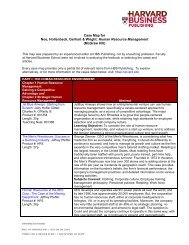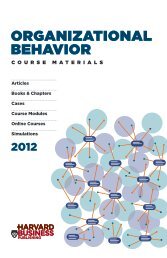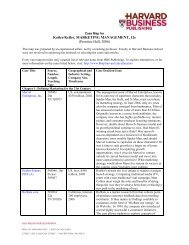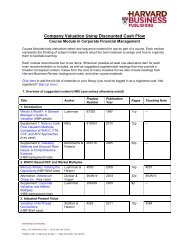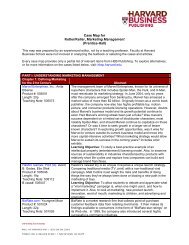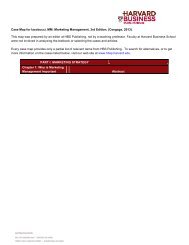teAcHing MATErIAlS - Harvard Business School Press
teAcHing MATErIAlS - Harvard Business School Press
teAcHing MATErIAlS - Harvard Business School Press
Create successful ePaper yourself
Turn your PDF publications into a flip-book with our unique Google optimized e-Paper software.
Sino-Forest (A)<br />
David F. hawkins, David Lane<br />
<strong>Harvard</strong> <strong>Business</strong> <strong>School</strong> Case<br />
Product #112004 (29 pages) tn<br />
B and C Cases Available<br />
A Chinese company listed on the Toronto<br />
Stock Exchange is accused of fraud by a<br />
hedge fund.<br />
Todovino: Can Your Rival Be Your<br />
Friend?<br />
F. Asis Martinez-Jerez, Lisa Brem<br />
<strong>Harvard</strong> <strong>Business</strong> <strong>School</strong> Case<br />
Product #111071 (20 pages) tn<br />
Todovino sells Spanish wines through wine<br />
clubs and web sites. Founder-CEO Gonzalo<br />
Verdera has partnered with many companies<br />
to create cobranded wine clubs, but now<br />
he is pondering a joint venture with one of<br />
his rivals, a brick-and-mortar wine chain.<br />
Todovino would provide the online presence<br />
for the chain. Should Verdera help his rival?<br />
What are the risks and benefits for Todovino?<br />
<strong>Business</strong> etHics<br />
Cipla 2011<br />
Rohit Deshpande, Sandra J. Sucher,<br />
Laura Winig<br />
<strong>Harvard</strong> <strong>Business</strong> <strong>School</strong> Case<br />
Product #511050 (25 pages)<br />
Dr. Yusuf Hamied, head of the Indian<br />
pharma and generics manufacturing company<br />
Cipla, is weighing options for how to<br />
continue to support the global fight against<br />
HIV/AIDS while positioning his company for<br />
growth in a changing regulatory landscape.<br />
The Drivers of Greenwashing<br />
Magali A. Delmas, Vanessa Cuerel<br />
Burbano<br />
California Management Review Case<br />
Product #CMR494 (24 pages)<br />
More and more firms are engaging in greenwashing,<br />
misleading consumers about their<br />
environmental performance or the environmental<br />
benefits of a product or service. The<br />
skyrocketing incidence of greenwashing can<br />
have profound negative effects on consumer<br />
and investor confidence in green products.<br />
Mitigating greenwashing is particularly challenging<br />
in a context of limited and uncertain<br />
tn TEAChiNG NOTE AVAiLABLE<br />
regulation. This article examines the external<br />
(both institutional and market), organizational,<br />
and individual drivers of greenwashing and<br />
offers recommendations for managers, policy<br />
makers, and NGOs to decrease its prevalence.<br />
economics<br />
A New Approach to Funding Social<br />
Enterprises<br />
Antony Bugg-Levine, Bruce Kogut,<br />
Nalin Kulatilaka<br />
<strong>Harvard</strong> <strong>Business</strong> Review Article<br />
Product #R1201K (7 pages)<br />
An increasing number of social entrepreneurs<br />
and investors are realizing that social<br />
enterprises of all sorts, including many<br />
organizations regarded as charitable nonprofits,<br />
can generate returns acceptable to<br />
the financial markets. The key is to view the<br />
funding of social enterprises as a problem of<br />
financial structuring. If they treat charitable<br />
donations as a form of capital that seeks<br />
social, not financial, returns, organizations<br />
can then tap traditional sources of funding:<br />
venture capital firms, banks, mutual funds,<br />
bonds, and so on. And with access to these<br />
sources, they can make use of all the tools for<br />
transferring risk and return, allowing them to<br />
free up capital and grow. For this to succeed,<br />
the social enterprise sector will need to create<br />
greater precision and transparency around<br />
measuring and reporting social outcomes,<br />
and policy makers must build the necessary<br />
market infrastructure and legal frameworks.<br />
With these efforts, social enterprises could<br />
have a larger universe of investors than<br />
conventional businesses do. This would be a<br />
significant step toward a greener, healthier,<br />
and more equitable world.<br />
A Note on Long-Run Models of<br />
Economic Growth<br />
Peter Rodriguez<br />
University of Virginia Darden <strong>School</strong> Case<br />
Product #UV4282 (12 pages)<br />
This technical note prepares students to use<br />
and analyze economic models of long-run<br />
growth. The technical note is particularly<br />
useful in introducing the Solow neoclassical<br />
growth model for discussing growth in<br />
emerging markets and developed economies.<br />
ACCOUNTING — BUSINESS ETHICS — ECONOMICS<br />
California Water Pricing<br />
Dorothy Robyn<br />
<strong>Harvard</strong> Kennedy <strong>School</strong> Case<br />
Product #HKS537 (14 pages) tn<br />
In many parts of California, water districts<br />
set prices so that agricultural users pay far<br />
less than residential users and far less than<br />
the true cost of water. While the adoption of<br />
a marginal cost pricing system would bring<br />
enormous efficiency gains, it would inevitably<br />
create losers as well as winners. To anticipate<br />
the problems of implementing such a pricing<br />
system in California, reformers need to<br />
anticipate which regions and which crops in<br />
California would be most affected. The case<br />
provides the information necessary to do a<br />
partial equilibrium incidence analysis, including<br />
data on the average factor share of water<br />
by crop, the average value created for each<br />
crop by marginal applications of water, the<br />
degree of interregional variation in the ratio<br />
of non-water inputs, and the role of each crop<br />
in the California and worldwide markets.<br />
Intrinergy: Carbon Offsets (A)<br />
Samuel E. Bodily, Brandon Ogilvie,<br />
Brett Brohl<br />
University of Virginia Darden <strong>School</strong> Case<br />
Product #UV4312 (6 pages)<br />
B Case Available<br />
The A case describes the decision the Bur-<br />
Mills textile company will make regarding<br />
whether to change from producing its own<br />
steam to outsourcing its steam production to<br />
Intrinergy. BurMills can calculate the present<br />
value of cost flows for three alternatives: producing<br />
its own steam from burning natural<br />
gas or outsourcing to Intrinergy with either<br />
a fixed price contract or with a price contract<br />
that floats with the natural gas price at Henry<br />
Hub. In addition to the standard costs associated<br />
with steam production, the case adds<br />
depth by providing the possibility of revenue<br />
from carbon credits. These credits are earned<br />
because the energy in the Intrinergy plant is<br />
created from biomass. A proper analysis will<br />
include a Monte Carlo simulation based on<br />
an arithmetic random walk for carbon credit<br />
pricing, a mean-reverting arithmetic random<br />
walk for Henry Hub natural gas spot prices,<br />
and other distributions.<br />
hbsp.harvard.edu 1-800-545-7685 | 5


